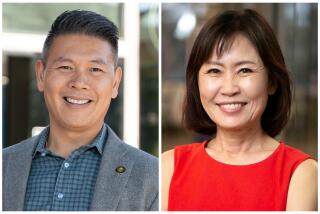25,000 Workers in 92 California Offices : Fervent Army of Democrats Seeks Votes
- Share via
Ruthless. Obsessed. And impossible to discourage.
That is the best way to describe the operation assembled by California Democrats to turn out their vote in Tuesday’s election.
Lt. Gov. Leo T. McCarthy, running for the U.S. Senate, says he has not seen anything like it in 25 years of politics.
Democratic presidential nominee Michael S. Dukakis recently conceded to KABC radio’s Michael Jackson that the California field operation may be the only thing standing between him and defeat in the state.
Skeptical reporters, long used to watching sloppy and often illusory get-out-the-vote efforts, have been stunned at the scope of the Democratic operation in visits around the state.
“This thing is amazing; it’s for real,” said Philip J. Trounstine, political editor for the San Jose Mercury News.
The state campaign for Republican nominee George Bush, by contrast, is running a more traditional operation that depends on loosely monitored volunteers and a scattering of phone banks.
With 92 offices and 25,000 workers from the North Coast to the Mexican border, the $4.5-million Dukakis operation hopes to buck the conventional wisdom that a voter contact program is not a major factor in something as huge as a presidential race.
There is no question it can work in local races, where the universe of voters is smaller and where television ads and news coverage are not as dominant as they are in presidential contests.
Cranston Credits Plan
But two years ago, U.S. Sen. Alan Cranston credited his squeaker reelection to the voter-contact plan set up by former United Farm Workers organizer Marshall Ganz.
Cranston was so impressed with what Ganz did that he urged Dukakis to try it on a larger scale in the state in 1988.
Dukakis supporters set up Campaign ‘88, an apparatus run by Kathy Garmezy, an official with the AFL-CIO in Los Angeles.
Organized labor provided many of the staff members for the operation and much of the office space around the state.
“We are determined to help Mike Dukakis and Leo McCarthy win,” said Garmezy, “but we are also looking beyond this election. We are trying to set up a lasting network that can get people involved in politics again at the neighborhood level.”
Early Friday morning, Campaign ’88 official Bob Lawson was far out in the San Fernando Valley, meeting with the field workers who will try to turn out the vote in the Van Nuys and Pacoima precincts.
“You have to be totally ruthless,” Lawson told his charges. “It is better to know if a precinct worker is not doing the job than to pretend that he is. We can replace people immediately who are not going to do the maximum to get out the vote on Tuesday.”
As with all of the other Dukakis field offices around the state, the Van Nuys-area operation has targeted what it calls “occasionals”--those Democrats they have found to be supporters of Dukakis but who may forget to vote or not bother to vote based on past voting history.
In other words, the Dukakis organizers say, it is an “extra” vote above and beyond the core of Democrats who can be counted on to turn out every election day.
“We believe we can turn out 700,000 of these occasional voters statewide,” said Lawson. “Many of them would not have voted if we had not made the personal contact with them we have made.
“All of this is based on a concept of neighbor-to-neighbor contact. The attitude our precinct workers convey to their neighbors is: ‘If I can spend my time on this, then it is important enough for you to at least vote on Election Day.’ It is a totally different concept from the mass media approach, which tends to be remote.”
The key, according to Larry Tramutola, who designed the Campaign ’88 model, is a constant monitoring of field operations to make sure the occasional voters are being reached.
Around the state, computerized lists are checked and rechecked. There are daily pep talks and, sometimes, harsh words for those not meeting their goals.
And there is a commitment that borders on obsession.
In the Riverside County office, coordinator Ellie Cohen zooms around the huge office as if she is on roller skates.
“In the last three weeks,” she says breathlessly, “we’ve contacted almost 50,000 of these occasional voters. My goal is to see that 30,000 of them vote on Tuesday. It is going to make a difference for Dukakis here.”
On the wall behind her are huge charts showing the numbers of voters reached either by phone or in person.
By Monday, all 92 field offices will have a “hard list” of voters to push to the polls on Election Day.
And on Tuesday, Campaign ’88 monitors will check at polling places to see who from their lists has not come in to vote. Efforts will be made to contact those voters throughout the day.
One thing that could dampen the California turnout effort is an early projection by the TV networks, based on East Coast voting, that Bush is going to win.
There is also the strong possibility that Bush’s lead over Dukakis--6 points in the latest California Poll--will be too great for the field operation to overcome.
More to Read
Get the L.A. Times Politics newsletter
Deeply reported insights into legislation, politics and policy from Sacramento, Washington and beyond. In your inbox twice per week.
You may occasionally receive promotional content from the Los Angeles Times.










